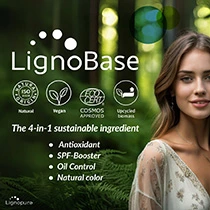Eastman launches biodegradable non-microplastic color cosmetic enhancer

Eastman Chemicals has launched its Esmeri CC1N10, a biodegradable and non-microplastic color cosmetic enhancer. It is intended for use in lipsticks, liquid foundations, and pressed powders, and can be used in all color cosmetic formulations.
“Esmeri is a sustainable micro powder solution formulated for color cosmetics. The cellulose ester micro powder is freshwater readily biodegradable, non-nano, sustainably sourced from 63% wood pulp, and compliant with the European Commission’s microplastics regulation,” Marty Boykin, director of Care Solutions & SFE Technology Division at Eastman Chemicals, tells Personal Care Insights.
He explains that Esmeri enhances color intensity in lipsticks and provides smoother, more even application with long-lasting coverage. In liquid foundations, it creates a soft-focus and mattifying effect that diminishes imperfections for a smooth and even finish.
“Pressed powders benefit from optimal compaction and pick-up, resulting in a photo-finished appearance,” says Boykin. “As a stable, lipophilic-compatible, and sustainable alternative to traditional microparticles, Esmeri empowers formulators to create high-quality products.”
A century of expertise
The ingredient is said to have leveraged over a century’s worth of cellulose ester technology and was initially developed for photographic film in the early 20th century, including use in the motion picture industry.
 The ingredient was initially developed for photographic film in the early 20th century.“Over time, Eastman developed new materials for other applications, including coatings, packaging, and various consumer products. As societal and regulatory pressures to eliminate microplastics from cosmetics intensified, we saw an opportunity to bring our expertise in cellulose chemistry to design biodegradable materials for the beauty industry,” says Boykin.
The ingredient was initially developed for photographic film in the early 20th century.“Over time, Eastman developed new materials for other applications, including coatings, packaging, and various consumer products. As societal and regulatory pressures to eliminate microplastics from cosmetics intensified, we saw an opportunity to bring our expertise in cellulose chemistry to design biodegradable materials for the beauty industry,” says Boykin.
In developing Esmeri, the company focused on two critical factors: ensuring the micro powder broke down in 28 days and delivering the performance consumers expect from color cosmetics.
“Through extensive testing and development, we were able to achieve both objectives — delivering a high-performing ingredient for color cosmetics that delivers soft-focus optical effects, enhanced color intensity, and uniform coverage while also meeting stringent environmental standards,” Boykin explains.
Consumers want more
Consumers are turning toward environmentally sustainable products that perform well, forcing beauty companies to focus on biodegradable personal care products that are good for the planet and human health. Plant-based ingredients in cosmetics have moved from being a niche to an expectation.
Microplastics have also gained attention in beauty products due to their wide use, high risks, and potential to penetrate the skin and interact with cells.
Boykin says Eastman’s consumer research validated the need for Esmeri as a sustainable alternative to traditional microparticles.  The ingredient is said to reduce the appearance of fine lines and wrinkles.
The ingredient is said to reduce the appearance of fine lines and wrinkles.
He details that the company surveyed 4,000 women aged 16–70 in the US, the UK, Brazil, France, and Germany. The results showed that consumers want more from their cosmetics regarding performance and sustainability.
Future applications
The ingredient is said to reduce the appearance of fine lines and wrinkles.
“Esmeri ’s properties enhance performance, resulting in a micro powder that optimally scatters light, filling in fine lines and wrinkles,” says Boykin.
He shares the company’s plans to expand the Esmeri brand with new high-performance, sustainable cellulose ester micro powder products designed to meet the various needs and expectations of the personal care and cosmetics industry, including skin care and sunscreen formulations.












